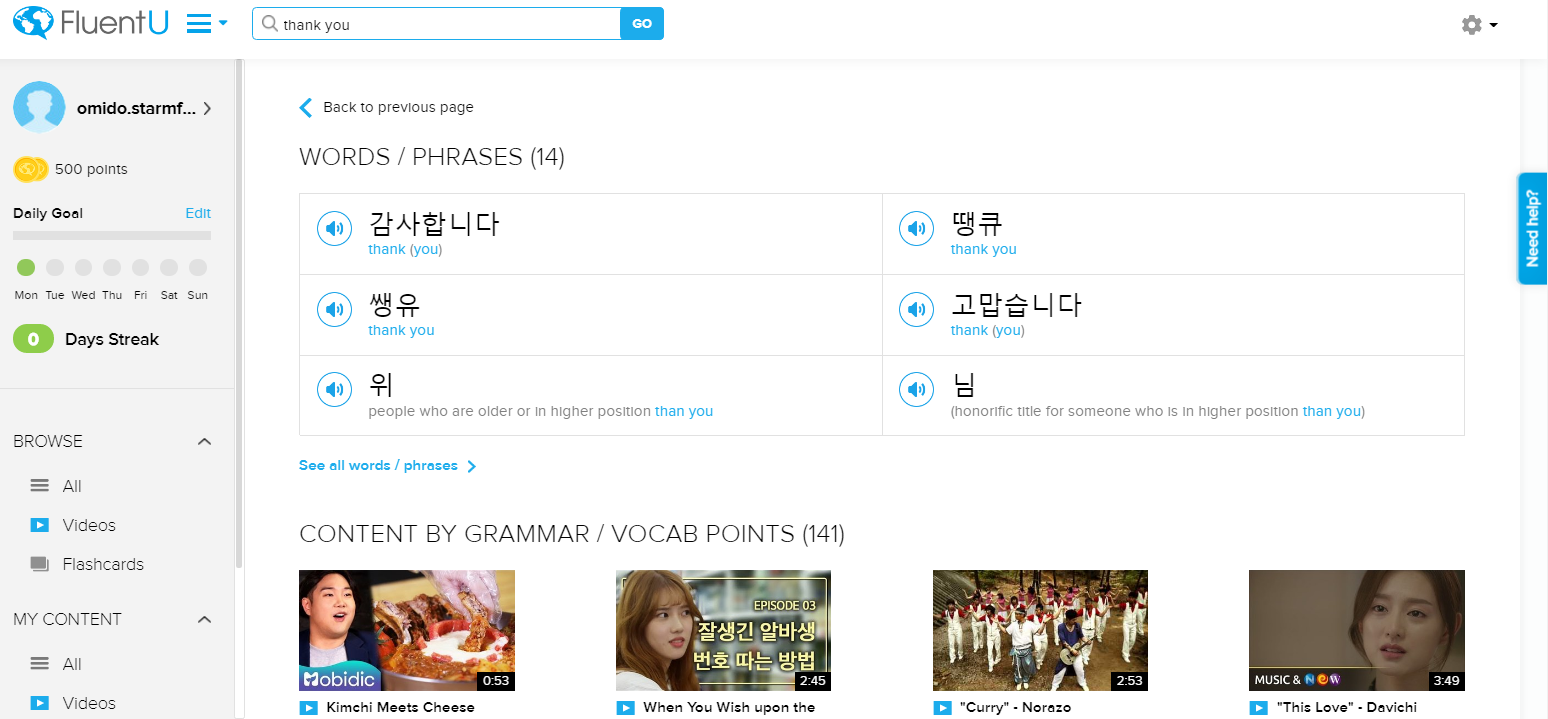Thanks Again U Be Able and I Uh
"Thank you" is one of the first things you learn to say as a kid.
It's also one of the first things you tend to learn when starting a new language.
And there's no question as to why that's the case!
Good manners are universal, and being able to express our gratitude is a basic method of showing courtesy across cultures.
Regardless of where you are in your Korean studies, you should definitely know how to say thanks in its different forms early in your language training.
But the simple phrase "thank you" does have a few intricacies when spoken in Korean. Find out exactly how and when to use "thank you" in Korean!
Download: This blog post is available as a convenient and portable PDF that you can take anywhere. Click here to get a copy. (Download)
How Saying "Thank You" Works in Korean
In English, giving thanks is a bit of a lenient affair. "Thank you" is our uncontested go-to, whereas "thanks" can be a bit more casual. There are also other sayings like "much obliged" or "I appreciate it" that you can play with.
It's a little different in Korean. Formality is one area that gets more attention, even with something as simple as giving thanks. As you may know, respect and etiquette is kind of a big deal in Korean culture, and the social rules trickle down to how you speak.
In the Korean language, speech levels exist. Speech levels essentially make up a "politeness system" that suggests how formal you should be when speaking with someone, ranking from "most formal" to "least formal." It's something that linguists would refer to as register, in which how you speak changes depending on the context in which you're speaking or to whom you're speaking.
Because of speech levels, verbalizing politeness is done in different ways, from assigning honorific titles to changing up the very grammatical structure of your sentences.
In the case of apologies, you'd use specific "I'm sorry" phrases according to your relationship with the recipient, which you can learn more about in the video below from the FluentU YouTube channel:
But if you want to make sure you always talk to someone appropriately, you'll have to learn honorifics. This video will help you with just that:
To explore other fun language learning content, don't forget to subscribe to the FluentU YouTube channel.
"Thank you" is also placed into different levels and is said in different ways depending on who's receiving the thanks.
Age difference can also affect how you say thank you . Like most East Asian cultures, Korean culture also retains the influence of Confucian principles that place a special significance on elders. Regardless of how close you are to someone, an age difference can still affect how you're expected to speak to them. The general rule is that older people tend to receive more formality, while those your age or younger can be treated more informally. Keep in mind that calculating your age in Korea is also its own little affair, so someone may be considered older than you expect.
So, to boil it all down: You can be too informal or formal when giving thanks, and it depends on to whom you're speaking. Don't be too intimidated though, as the boundaries are often quite clear. To play it safe, stick to formal phrases for everyday business (save for friends, of course, who might be amused by your stuffiness).
One of the best ways to master when to use these phrases is to watch how they're used by native speakers in authentic contexts. Since a trip to Korea might be out of the question, an easier alternative is to use FluentU's video search function to find cool content that includes these phrases.


If you're watching a video and don't recognize a word, you can click on the interactive captions to find out more about it and see it used in example sentences and other videos.
You can also make your own vocabulary lists and flashcard sets with the Korean phrases for thank you or with any other vocab you want to learn! Then, quiz yourself to see what you remember after a study session.
Sign up for a free trial to see some videos that use the various Korean phrases for "thank you!"
12 Ways to Say Thank You and You're Welcome in Korean
1. 감사합니다 (gahm-sa-hab-ni-da) — Thank you
This is the most common formal way to say thanks and what you can consider as your safe go-to for most situations. In the speech level system, this would be placed in the general formal level, which you'd use for strangers or those who are your seniors (in age or rank).
감사 is the part that means "thanks" or "gratitude." 니다 is a formality-infused form of the basic Korean verb phrase "to be," 이다 (ii-da). 니다 is the part that shows you're being respectful.
Add what you're giving thanks to before this phrase, like this:
선물을 주셔서 감사합니다 (sun-mul-eul ju-shuh-suh gahm-sa-hab-ni-da) — Thank you for the gift.
2. 고맙습니다 (go-map-seup-ni-da) — Thank you
This, too, is considered relatively formal and polite (니다 is still in the phrase!), though at times it seems more appropriate for people you're a bit more familiar with or closer to in age. It's also generally safe for use in less serious or casual contexts, such as in a store. You probably wouldn't want to use this in a business meeting where you're meeting important folks!
If you're still in doubt as to when to use this one, don't stress out about it too much. You can just fall back on 감사합니다, but there's really no strong difference between that phrase and this one in daily, non-business contexts.
3. 고마워요 (go-ma-wo-yo) — Thank you
Notice the lack of 니다 here! At last, a breather from stuffy speech. This is still relatively polite but definitely a formality downgrade from the other two. Use this for those you're reasonably familiar with, whether a friend or classmate, or for those you're closer to in age.
4. 정말 고마워요 (jung-mal go-ma-wo-yo) — Thank you sincerely
This phrase emphasizes the previous 고마워요.
정말 can translate to "truly" or "sincerely," and you can tack it on to the more formal aforementioned phrases as well for a little oomph. Just because you loosen up on formality doesn't mean you do the same for your level of gratitude!
5. 고마워 (go-ma-wo) — Thank you
There aren't any special formality endings for this phrase, which means it's reserved for friends, siblings, those who are your age or younger and those who are your junior in rank/social standing. By removing 요 from 고마워요, you get your first casual way to say thanks!
6. 대단히 감사합니다 (dae-dan-hi gahm-sa-hab-ni-da) — Thank you very much
This is for special cases where your gratitude is strong and the person truly deserves a lot of it for whatever favor they did for you. 대단히 means "very much" or "greatly." This phrase uses the formal 감사합니다, making this quite a respectful and weighty thanks.
7. 정말 친절하시네요 (jung-mal chin-jul-ha-si-ne-yo) — That's truly kind of you
정말 makes an appearance once again to add the "truly" part to this phrase. 친절 means kindness, and 하시네요 is a conversion of the verb phrase "to do," so together this whole phrase is telling the person that they're "doing kindness" to you.
8. 아니요 괜찮습니다 (ah-ni-yo gwoen-chan-seup-ni-da) — No, thank you
아니요 is a negatory response, while 괜찮습니다 would translate more literally to "it's okay." 니다 is once again present to wrap up this phrase with a ribbon of formality.
9. 아니요 괜찮아요 (ah-ni-yo gwoen-chan-ah-yo) — No, thank you
This is a less formal version of the previous phrase. You're probably picking up on the pattern that occurs when 니다 is switched with a 요.
10. 감사 (gahm-sa) — Thanks
This is essentially the slang form of saying thanks; as it goes, slang often works to cut down basic common phrases to their essentials. This is certainly informal and very casual, probably something you'll see in text messages or hear in conversations with friends.
11. 천만에요 (chun-man-eh-yo) — You're welcome
We can't learn all these ways to say thank you without learning how to respond to them! Here's a "you're welcome" phrase you'll probably find in textbooks, though you may not actually hear it used often. That's because it's a bit dated, and Korean natives won't usually respond to thanks with this phrase. You can still use it though, to show that you appreciate the thanks.
12. 아닙니다 or 아니에요 (ah-nip-ni-da/ah-ni-eh-yo) — It's nothing/No problem
These two phrases almost literally translate to "it's not" or "it's nothing." The former is more formal, the latter less so. This is what you'll probably hear more often in native conversations, as opposed to 천만에요.
A simple way to impress a native speaker is by being able to express your gratitude in his or her language. Not only does it show that you know the language, but it also exemplifies your understanding of courtesy. So, always mind your manners!
Thanks for reading, or as you would say in Korean, 읽어주셔서 감사합니다 (ilg-uh-ju-syuh-suh gahm-sa-hab-ni-da)!
Download: This blog post is available as a convenient and portable PDF that you can take anywhere. Click here to get a copy. (Download)
Source: https://www.fluentu.com/blog/korean/thank-you-in-korean/
0 Response to "Thanks Again U Be Able and I Uh"
Postar um comentário